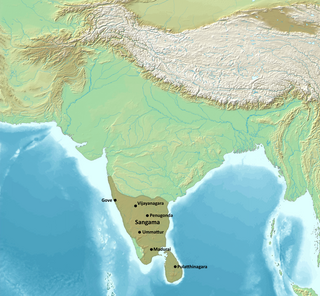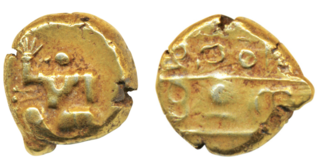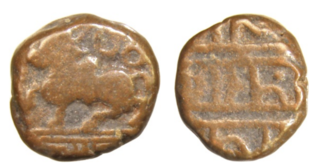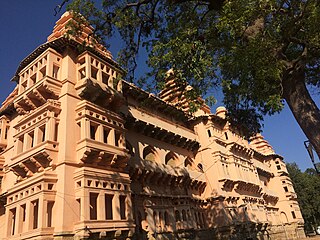This article needs additional citations for verification .(November 2012) |
| |||||
| Centuries: | |||||
|---|---|---|---|---|---|
| Decades: | |||||
| See also: | List of years in India Timeline of Indian history | ||||
Events from the year 1505 in India.
This article needs additional citations for verification .(November 2012) |
| |||||
| Centuries: | |||||
|---|---|---|---|---|---|
| Decades: | |||||
| See also: | List of years in India Timeline of Indian history | ||||
Events from the year 1505 in India.

The Vijayanagara Empire was a medieval Indian empire that covered much of the region of Southern India, ruling the lands of the modern states of Karnataka, Andhra Pradesh, Tamil Nadu, Kerala, Goa, and some parts of Telangana and Maharashtra. It was established in 1336 by the brothers Harihara I and Bukka Raya I of the Sangama dynasty, members of a pastoralist cowherd community that claimed Yadava lineage. The empire rose to prominence as a culmination of attempts by the southern powers to ward off Turco-Persian Muslim invasions by the end of the 13th century. At its peak, it conquered almost all of Southern India's ruling dynasties and pushed the Turco-Persian sultans of the Deccan beyond the Tungabhadra-Krishna river doab region, in addition to annexing Gajapati Empire (Odisha) till Krishna river, thus becoming a notable power. It lasted until 1646, although its power declined after a major military defeat in the Battle of Talikota in 1565 by the combined armies of the Deccan sultanates. The empire is named after its capital city of Vijayanagara, whose ruins surround present day Hampi, now a UNESCO World Heritage Site in Karnataka, India. The wealth and fame of the empire inspired visits by and writings of medieval European travelers such as Domingo Paes, Fernão Nunes, and Niccolò de' Conti. These travelogues, contemporary literature and epigraphy in the local languages, and modern archeological excavations at Vijayanagara have provided ample information about the history and power of the empire.

The history of southern India covers a span of over four thousand years during which the region saw the rise and fall of a number of dynasties and empires.

Krishnadevaraya was an emperor of the Vijayanagara Empire reigning from 1509 to 1529. He was the third monarch of the Tuluva dynasty, and is considered to be one of the greatest rulers in Indian history. He ruled the largest empire in India after the fall of the Islamic Delhi Sultanate. Presiding over the empire at its zenith, he is regarded as an icon by many Indians. Krishnadevaraya earned the titles Andhra Bhoja, Karnatakaratna Simhasanadeeshwara, Yavana Rajya Pratistapanacharya, Kannada Rajya Rama Ramana, Gaubrahmana Pratipalaka and Mooru Rayara Ganda. He became the dominant ruler of the peninsula by defeating the sultans of Bijapur, Golconda, the Bahmani Sultanate and the Gajapatis of Odisha, and was one of the most powerful Hindu rulers in India.

BukkaRaya I was an emperor of the Vijayanagara Empire from the Sangama Dynasty. He was a son of Bhavana Sangama, the chieftain of a cowherd pastoralist community, who claimed Yadava descent.

Deva Raya II was an emperor of the Vijayanagara Empire. The greatest of the Sangama dynasty rulers, he was an able administrator, warrior, and scholar. He authored well-known works in the Kannada language and in the Sanskrit language. He was patron to some of the most noted Kannada poets of the medieval period, including Chamarasa and Kumara Vyasa, the Sanskrit poet Gunda Dimdima, and the noted Telugu language poet Srinatha, whom the king honored with the title Kavisarvabhauma. He supported development in secular literature as well as the noted South Indian mathematician Parameshvara, from the Kerala school of astronomy and mathematics lived in his empire.
The Saluva dynasty was created by the Saluvas, who by historical tradition were natives of the Kalyani region of northern Karnataka in modern India. The Gorantla inscription traces their origins to this region from the time of the Western Chalukyas and Kalachuris of Karnataka. The term "Saluva" is known to lexicographers as "hawk" used in hunting. They later spread into the east coast of modern Andhra Pradesh, perhaps by migration or during the Vijayanagara conquests during the 14th century.
Tuluva is the name of the third Dynasty of the Vijayanagara Empire. The dynasty traces its patrilineal ancestry to Tuluva Narasa Nayaka, a powerful warlord from the westerly Tulu speaking region. His son Narasimha Nayaka arranged for the assassination of the weak Narasimha Raya II bringing an end to the rule of the Saluva dynasty. Narasimha Nayaka later assumed the Vijayangara throne as Viranarasimha Raya bringing the Tuluva dynasty to prominence. The dynasty was at its zenith during the rule of Krishnadevaraya, the second son of Tuluva Narasa Nayaka.

Vyāsatīrtha, also called Vyasaraja or Chandrikacharya, was a Hindu philosopher, scholar, polemicist, commentator and poet belonging to the Madhwacharya's Dvaita order of Vedanta. As the patron saint of the Vijayanagara Empire, Vyasatirtha was at the forefront of a golden age in Dvaita which saw new developments in dialectical thought, growth of the Haridasa literature under bards like Purandara Dasa and Kanaka Dasa and an amplified spread of Dvaita across the subcontinent. Three of his polemically themed doxographical works Nyayamruta, Tatparya Chandrika and Tarka Tandava documented and critiqued an encyclopaedic range of sub-philosophies in Advaita, Visistadvaita, Mahayana Buddhism, Mimamsa and Nyaya, revealing internal contradictions and fallacies. His Nyayamruta caused a significant stir in the Advaita community across the country requiring a rebuttal by Madhusudhana Saraswati through his text, Advaitasiddhi. He is considered as an amsha of Prahlada in the Madhva Parampara.
Saluva Narasimha Deva Raya was an emperor of the Vijayanagara Empire from the Saluva Dynasty. A patron of the Madhwa saint Sripadaraya, he authored the Sanskrit work Rama Bhyudayam. He also patronised Kannada poet Kavi Linga.
Pemmasani Nayaks were a ruling clan in the south Indian state of Andhra Pradesh. They came into prominence during Vijayanagara Empire. After the Battle of Talikota in 1565 AD, the collapse of Vijayanagara Empire led to the emergence of Pemmasani Nayakas in the Rayalaseema region. They belonged to the Kamma social group.
Tuluva Narasa Nayaka was an Indian general and later an Imperial Regent who founded the Tuluva dynasty of the Vijayanagara Empire. He was the father of the Emperors Viranarasimha Raya, Krishnadevaraya and Achyuta Deva Raya.
Vira Narasimha Raya became the Emperor of Vijayanagara after the death of his predecessor Narasimha Raya II. He was the older half-brother of Krishnadevaraya.
Thimma Bhupala was the elder son of Saluva Narasimha Deva Raya, the King of Vijayanagara Empire. During the reign of his father, he was holding the office of Yuvaraja Prince Thimma succeeded his father in 1491 but was soon murdered by an army commander during a period of political unrest in Vijayanagara. He was succeeded by his younger brother Narasimha Raya II.
Narasimha Raya II ( Narasimha II, Immadi Narasimha Raya or Dhamma Thimma Raya) was the third and last ruler of the Saluva dynasty, the second of the four dynasties to rule the Vijayanagara Empire.

The Battle of Raichur was a battle fought between the Vijayanagara Empire and the Sultanate of Bijapur in 1520 in the town of Raichur, India. It resulted in a decisive victory for Vijayanagara forces, and the Bijapur ruler was defeated and pushed across the river Krishna.
Pemmasani Ramalinga Nayudu was an army commander of a Vijayanagara military unit. An inscription dated to 1544 CE, which was found in Tallaproddatu, states that Pemmasani Ramalinga enjoyed the nayankara of the village. Phillip B. Wagoner who analysed 17th century Telugu text Rayavachakamu noted that it is not known whether Ramalinga Nayudu served Krishnadeva Raya or some later ruler.
Events from the year 1509 in India.
Events from the year 1529 in India.

Chandragiri Fort is an historical fort located in the Chandragiri suburb of Tirupati. It is situated in Tirupati district of Andhra Pradesh, India. It is mostly associated with the Vijayanagara Emperors. In 1460 A.D. Odra Gajapati Kapilendra Dev captured the Chandragiri Fort.
Chamarajara Wodeyar II was fourth raja of the Kingdom of Mysore from 1478 until 1513.